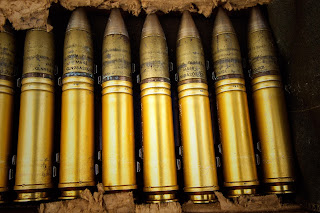Currently, arms and ammunition form a large part of major nations’ annual expenditures. This is because nations around the world are grappling with terrorist threats that have necessitated overhauling their defense capabilities. In this regard, organizations such as the North Atlantic Treaty Organization (NATO) are working towards counteracting terrorism by improving awareness of the threat, enhancing capabilities to prepare and respond, and intensifying engagement with partner nations and other international entities. Consequently, procuring and developing state-of-the-art weaponry and ammunition has become a high priority for nations worldwide.
In the light of political developments and incorporation of hi-tech weaponry to combat terrorism, the global ammunition market will rise at a CAGR of 3.7% from 2015 to 2021, says Transparency Market Research.
Q. What are the core factors driving the global ammunition market?
A. Nations around the world are striving to safeguard national security, thereby spending heavily on modern weaponry and ammunition. These measures are closely related to securing the country’s economy and the lives of its citizens. The rising concerns due to geopolitical disputes and changing military and law enforcement mandates as preparatory measures to respond to contingency are boosting the growth of the ammunition market across the world. Continual research and development for technologically advanced weaponry is also improving the demand for ammunition globally. With the rising popularity of shooting-related sports, the ammunition market is receiving a further boost.
Q. How lucrative are Asia Pacific and the Middle East and Africa regions for the global ammunition market?
A. Enormously. The increasing arms race in these regions due to some of the most brutal terrorist attacks in nations here in the past are the reason for this. Nations in these countries are striving to gear their armed forces to combat terrorist activities and be prepared in the instance of an eventuality.
For instance, following the 26/11 terror attack in Mumbai in India, several security measures were implemented. The entire west coast is now under continuous surveillance by aircraft and ships of the Navy and Coast Guard. The country is also making massive investments in ammunition in view of its conflicts with China and Pakistan.
Q. Where does Europe stand in the ammunition market globally?
A. The region is positioned as a clear leader in the global ammunition market. In 2014, the region contributed a revenue of 35% to the global market. Meticulous efforts carried out for the modernization of the armed forces and the increasing adoption of technologically developed ammunition are the reasons for the same. European countries such as France and Belgium, where recent terrorist attacks have left hundreds dead, are being compelled to strengthen their capacity to counter insurgents.
Q. Is demilitarization in Europe negatively impacting the ammunition market?
A. Yes. With the beginning of demilitarization in Europe in the 1970s that solidified in the 1990s and finally aggravated with the financial crisis of 2008, the demilitarization in Europe is undeniable. The reasons for this are the shrinking budgets leading to smaller armed troops, deployment of equipment in small quantities, and inadequate military capacity. Resultantly, demilitarization is resulting in shaky demand for ammunition in the region.
In the light of political developments and incorporation of hi-tech weaponry to combat terrorism, the global ammunition market will rise at a CAGR of 3.7% from 2015 to 2021, says Transparency Market Research.
Q. What are the core factors driving the global ammunition market?
A. Nations around the world are striving to safeguard national security, thereby spending heavily on modern weaponry and ammunition. These measures are closely related to securing the country’s economy and the lives of its citizens. The rising concerns due to geopolitical disputes and changing military and law enforcement mandates as preparatory measures to respond to contingency are boosting the growth of the ammunition market across the world. Continual research and development for technologically advanced weaponry is also improving the demand for ammunition globally. With the rising popularity of shooting-related sports, the ammunition market is receiving a further boost.
Q. How lucrative are Asia Pacific and the Middle East and Africa regions for the global ammunition market?
A. Enormously. The increasing arms race in these regions due to some of the most brutal terrorist attacks in nations here in the past are the reason for this. Nations in these countries are striving to gear their armed forces to combat terrorist activities and be prepared in the instance of an eventuality.
For instance, following the 26/11 terror attack in Mumbai in India, several security measures were implemented. The entire west coast is now under continuous surveillance by aircraft and ships of the Navy and Coast Guard. The country is also making massive investments in ammunition in view of its conflicts with China and Pakistan.
Q. Where does Europe stand in the ammunition market globally?
A. The region is positioned as a clear leader in the global ammunition market. In 2014, the region contributed a revenue of 35% to the global market. Meticulous efforts carried out for the modernization of the armed forces and the increasing adoption of technologically developed ammunition are the reasons for the same. European countries such as France and Belgium, where recent terrorist attacks have left hundreds dead, are being compelled to strengthen their capacity to counter insurgents.
Q. Is demilitarization in Europe negatively impacting the ammunition market?
A. Yes. With the beginning of demilitarization in Europe in the 1970s that solidified in the 1990s and finally aggravated with the financial crisis of 2008, the demilitarization in Europe is undeniable. The reasons for this are the shrinking budgets leading to smaller armed troops, deployment of equipment in small quantities, and inadequate military capacity. Resultantly, demilitarization is resulting in shaky demand for ammunition in the region.

No comments:
Post a Comment